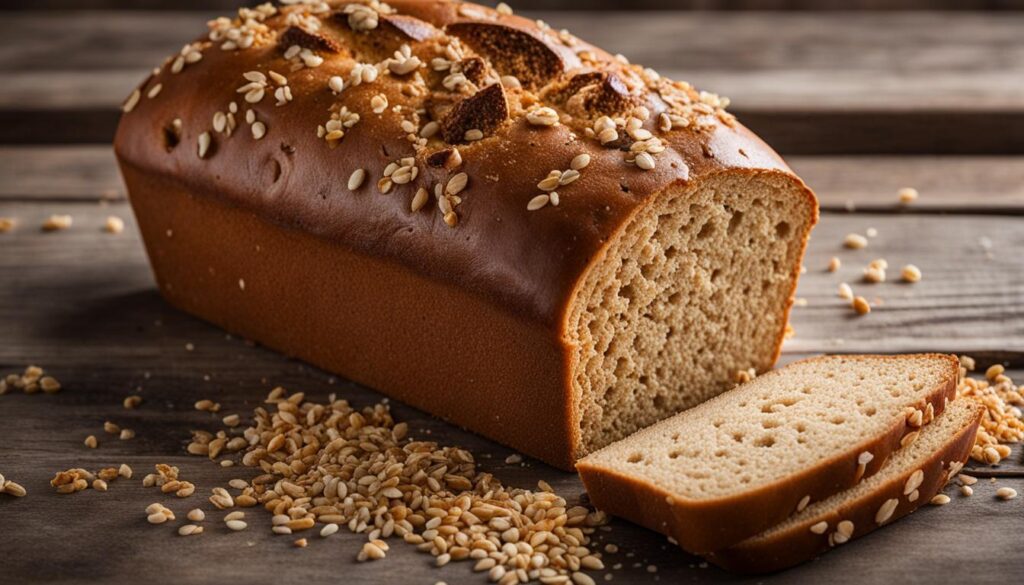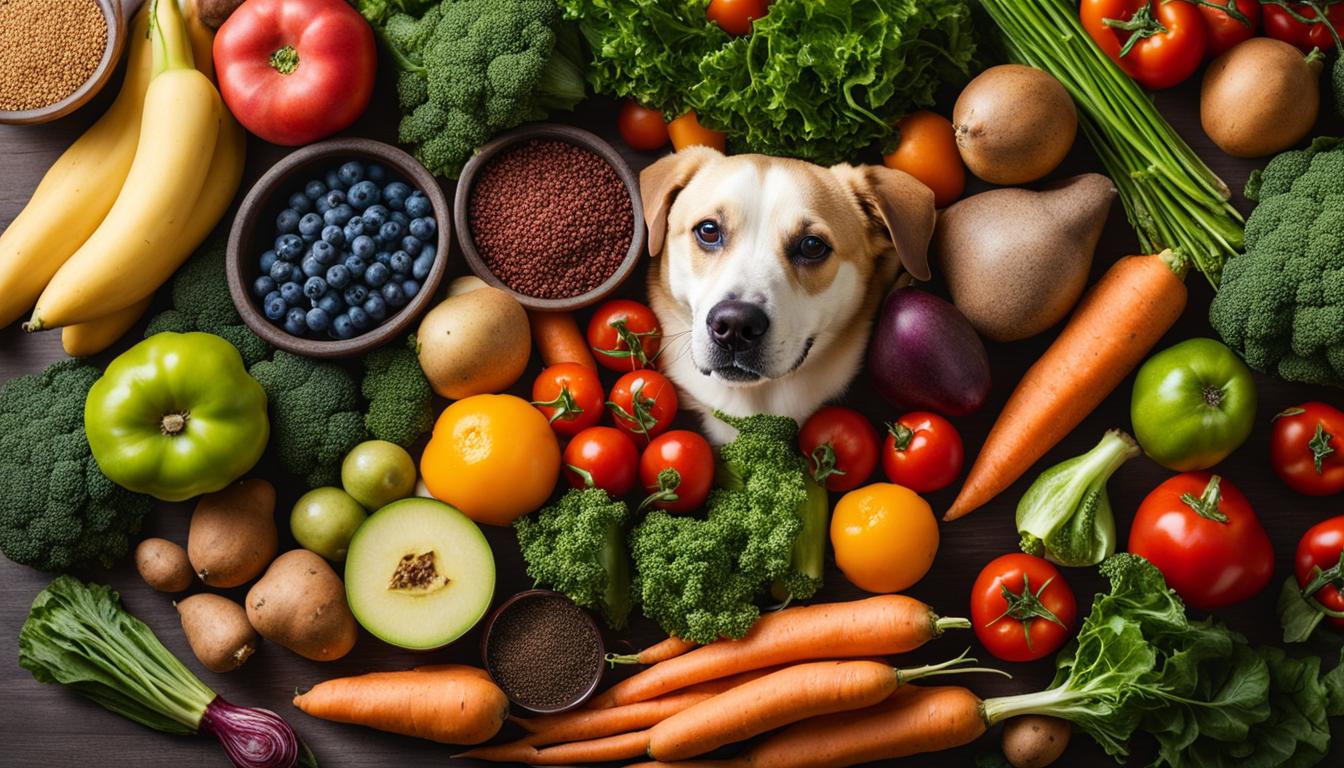Are you wondering if it’s safe for your furry friend to munch on some bread? Well, the good news is that dogs can eat bread in moderation. Plain white and wheat bread are generally safe for dogs, as long as they don’t have any allergies. So, you can breathe a sigh of relief if your pup snatches a bite from your sandwich! Just remember, bread should be given as a treat and not a staple in their diet.
Now, let’s dig deeper into the world of bread and find out what ingredients are safe for our four-legged companions.
Key Takeaways:
- Plain white and wheat bread are safe for dogs, as long as they don’t have any allergies.
- Feeding bread as a treat won’t harm dogs, but it should not be a significant part of their diet to avoid obesity.
- Avoid feeding dogs bread dough, as it can cause bloat and alcohol toxicosis.
- Some ingredients in bread, such as raisins, garlic, nuts, and xylitol, are toxic to dogs and should be avoided.
- Consider a balanced diet for your dog and consult with a veterinarian for specific dietary needs and concerns.
Risks of Feeding Bread Dough to Dogs
Feeding bread dough to dogs can pose serious risks to their health. When a dog consumes bread dough, the yeast in the dough continues to ferment and produce gas. This can cause the dog’s stomach to distend, leading to a condition called bloat. Bloat is a life-threatening condition that can result in the stomach twisting, cutting off blood flow to the organs, and causing severe pain and distress for the dog.
In addition to bloat, bread dough ingestion can also result in alcohol toxicosis. As the yeast ferments, it produces ethanol, which is a form of alcohol. The ethanol is absorbed into the dog’s bloodstream, leading to alcohol poisoning. This can cause symptoms such as depression, weakness, seizures, hypothermia, and even coma. If you suspect that your dog has consumed bread dough, it is crucial to seek immediate veterinary attention to prevent further complications.
“Feeding bread dough to dogs can lead to dangerous conditions like bloat and alcohol poisoning. It is essential to keep bread dough out of a dog’s reach and seek veterinary care if ingestion occurs.”
To ensure the safety of your furry friend, it is important to keep bread dough out of their reach and be cautious when baking or working with dough in their presence. Take care to dispose of any leftover dough properly and keep an eye on countertops or tables where dough may be accessible. By being vigilant and aware of the risks, you can help protect your dog from the dangers of consuming bread dough.
| Signs of bread dough ingestion: | Actions to take: |
|---|---|
| Bloating | Seek immediate veterinary attention |
| Abdominal discomfort | Do not induce vomiting without consulting a veterinarian |
| Weakness or lethargy | Monitor for signs of alcohol toxicosis |
| Unsteady gait or loss of coordination | Keep the dog calm and limit their movement |
Remember, prevention is key when it comes to keeping your dog safe. By being mindful of the risks associated with bread dough ingestion and taking appropriate precautions, you can help ensure that your furry friend stays healthy and happy.

Toxic Ingredients in Bread
When it comes to dogs and bread, there are certain ingredients that can be toxic and should be avoided. It’s important to read labels carefully and steer clear of breads that contain these harmful substances:
- Raisins: Raisins, even in small quantities, can cause kidney failure in dogs. So it’s crucial to avoid breads that have raisins as an ingredient.
- Garlic: While garlic can add flavor to human meals, it can be toxic to dogs. It can cause abdominal pain, vomiting, diarrhea, weakness, and even collapse. So it’s best to avoid breads that contain garlic.
- Nuts: Some breads may contain nuts or seeds, such as macadamia nuts. These can lead to stomach irritation and even pancreatitis in dogs due to their high fat content. It’s wise to check the ingredients list and avoid breads with nuts.
- Xylitol: This artificial sweetener is commonly used in sugar-free breads. However, xylitol is highly toxic to dogs and can cause a sudden release of insulin, resulting in dangerously low blood sugar levels. It’s essential to be vigilant and avoid breads with xylitol.
Being aware of these toxic ingredients in bread and carefully checking labels can help ensure the safety and well-being of your furry friend.
Bread and Digestive Issues in Dogs
When it comes to dogs and digestive issues, bread can be a mixed bag. While some dogs may tolerate bread without any problems, others may experience discomfort and digestive issues after consuming it. It’s important to understand the potential impact of bread on your dog’s digestive system and take appropriate measures to ensure their well-being.
Bread as a Dog Treat:
- Bread can be given to dogs as a treat, but it should be done in moderation.
- Excess consumption of bread can lead to weight gain and obesity-related issues.
- It’s important to balance bread with a nutritious diet and consider your dog’s specific dietary needs.
Bread for Dogs with Upset Stomachs:
- In some cases, bread can be used as a temporary solution for dogs with upset stomachs.
- However, it’s recommended to feed a bland diet of rice and boiled chicken to alleviate gastrointestinal issues.
- Consulting with a veterinarian is crucial to determine the best course of action for your dog’s individual needs.
Bread and Dog Digestive Issues:
- Bread contains gluten, which can be difficult for some dogs to digest.
- This can result in bloating, gas, and other digestive discomforts.
- If you notice your dog experiencing digestive issues after consuming bread, it’s advisable to limit or avoid bread altogether.

Table: Common Digestive Issues Associated with Bread Consumption
| Digestive Issue | Symptoms |
|---|---|
| Bloating | Abdominal distension, discomfort, and excessive gas |
| Gas | Excessive flatulence |
| Diarrhea | Loose, watery stools |
| Upset Stomach | Nausea, vomiting, and general GI discomfort |
“While bread can be enjoyed by some dogs, it’s important to be mindful of its potential impact on their digestive system. Just like humans, dogs have different sensitivities and tolerances to certain foods. If you notice any digestive issues after giving your dog bread, it’s best to consult with your veterinarian for guidance on their specific dietary needs.” – Dr. Sarah Thompson, DVM
Nutritional Value of Bread for Dogs
Bread has limited nutritional value for dogs. While it does provide carbohydrates, it lacks essential nutrients required for a balanced diet. White bread is highly processed and offers little nutritional value. Whole grain or wheat breads may have slightly more fiber and nutrients, but they should still be given sparingly. Dogs primarily thrive on protein-based diets. Feeding too much bread can result in an unbalanced diet and contribute to weight gain or other health problems over time. It’s best to view bread as an occasional snack rather than a regular part of a dog’s meals.
When it comes to providing your dog with a well-rounded diet, bread should not be relied upon as a primary source of nutrition. While it may be tempting to share a piece of bread with your furry friend, it’s important to remember that dogs have different dietary needs than humans. Bread is generally low in essential nutrients such as vitamins, minerals, and proteins that are necessary for a dog’s overall health and well-being.
If you choose to give your dog bread as a treat, opt for whole grain varieties that contain more fiber. However, keep in mind that even whole grain bread should be given in moderation. Too much bread can lead to weight gain and obesity in dogs, which can increase the risk of other health issues such as diabetes, joint problems, and heart disease. It’s always best to consult with your veterinarian to determine the appropriate amount and frequency of bread treats for your specific dog’s needs.

The Nutritional Value of Different Types of Bread
| Bread Type | Protein Content | Fiber Content | Fat Content | Calories per Slice |
|---|---|---|---|---|
| White Bread | 2g | 1g | 1g | 79 |
| Whole Wheat Bread | 4g | 3g | 1g | 81 |
| Whole Grain Bread | 4g | 4g | 1g | 80 |
As you can see from the table above, the nutritional differences between different types of bread are minimal. While whole wheat and whole grain breads may offer slightly more protein and fiber than white bread, the overall nutritional value is still relatively low. It’s important to remember that these values are approximate and may vary depending on the brand and specific ingredients used.
In conclusion, bread can be given to dogs as an occasional treat, but it should not be a significant part of their diet. While it may be tempting to share your bread with your furry friend, it’s important to prioritize their health and well-being by providing them with a balanced diet that meets their nutritional needs. Remember to consult with your veterinarian for personalized dietary advice for your dog.
Bread and Dog Weight: Understanding the Impact
When it comes to managing your dog’s weight, it’s important to consider the impact of bread consumption. While dogs can enjoy bread in moderation, excessive consumption can lead to weight gain and obesity-related health issues. Understanding the relationship between bread and dog weight is crucial for maintaining your furry friend’s overall health and well-being.
Bread is often high in carbohydrates and calories, which can contribute to weight gain if not monitored closely. Just like in humans, an excess of carbohydrates can be stored as fat in dogs, leading to unwanted weight gain. Furthermore, some types of bread may contain added sugars and fats, further increasing its calorie content. It’s essential to be mindful of the amount and frequency of bread given to your dog, especially if they are already overweight or prone to obesity-related health problems.
A slimming diet for dogs with bread might be necessary if your canine companion needs to shed a few pounds. This involves reducing their overall caloric intake, which includes limiting the consumption of bread. Instead of using bread as a treat or snack, focus on providing your dog with a balanced diet that consists of primarily protein-based foods. Consult with your veterinarian to determine the right amount of bread, if any, that your dog can safely consume while on a slimming diet.
| Bread Type | Carbohydrate Content per 100g | Calories per 100g |
|---|---|---|
| White Bread | 49g | 265 |
| Whole Wheat Bread | 45g | 247 |
| Multigrain Bread | 43g | 255 |
As shown in the table above, different types of bread have varying carbohydrate and calorie contents. White bread tends to have higher levels of both compared to whole wheat or multigrain bread. If you choose to include bread in your dog’s diet, opt for whole wheat or multigrain bread instead of white bread, as these options generally offer slightly more fiber and nutrients.
Remember, bread should be viewed as an occasional snack rather than a regular part of your dog’s meals. Prioritize a balanced diet that meets their nutritional needs, and consult with your veterinarian for guidance on managing your dog’s weight and dietary requirements.
Conclusion on Dogs Eating Bread
In conclusion, dogs can enjoy bread in moderation, but it’s important to understand the potential risks and limitations. Plain white or wheat bread is generally safe for dogs, as long as they don’t have any allergies. However, it’s crucial to remember that bread is essentially a filler food with limited nutritional value. It should not be a significant part of a dog’s diet to avoid weight gain and obesity-related health problems.
While bread can be given as an occasional treat, it’s important to be cautious of certain ingredients that can be toxic to dogs. Raisins, garlic, nuts, and xylitol are all ingredients that should be avoided in bread. These can cause serious health issues for dogs, including kidney failure, abdominal pain, weakness, and even coma. Always check labels and ingredients before feeding bread to your furry friend.
When it comes to your dog’s dietary needs, it’s best to consult with a veterinarian. They can provide specific advice based on your dog’s health, age, and individual needs. They can guide you on how to incorporate bread or other treats into your dog’s diet in a safe and balanced way. Remember, every dog is unique, and what works for one may not work for another.
So, while you can share a small piece of bread with your pup on occasion, it’s important to prioritize their overall health and well-being. Treats like bread should be just that – treats. Don’t let them become a major part of your dog’s diet. With a balanced approach and veterinarian guidance, you can ensure your dog’s happiness and health for years to come.
FAQ
Can dogs eat bread?
Yes, dogs can safely eat bread in moderation.
What types of bread are safe for dogs?
Plain white and wheat bread are generally safe for dogs, provided they don’t have any allergies.
Are there any risks associated with feeding bread dough to dogs?
Yes, bread dough can be dangerous for dogs as it can cause bloating and release toxic levels of ethanol into the bloodstream.
Are there any toxic ingredients in bread that dogs should avoid?
Yes, raisins, garlic, nuts, and xylitol can be toxic to dogs and should be avoided.
Can bread help with digestive issues in dogs?
While bread may be considered a treat for dogs with upset stomachs, a bland diet of rice and boiled chicken is recommended.
Does bread have any nutritional value for dogs?
Bread is essentially a filler food with limited nutritional value for dogs.
Can bread consumption affect a dog’s weight?
Yes, excessive bread consumption can contribute to weight gain and obesity-related health issues in dogs.
Can dogs eat bread as a regular part of their diet?
No, bread should be given as an occasional treat and not a significant part of a dog’s diet.





